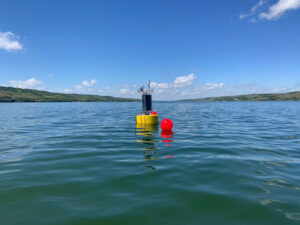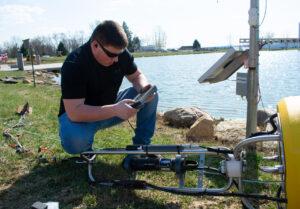Thermo Orion Star A211 Benchtop pH Meter
Features
- Displays pH, mV, RmV and temperature readings using any Orion BNC pH electrode
- AUTO-READ function alerts user and locks stable readings on backlit LCD screen
- USB and RS-232 ports allow easy transfer of up to 2000 time-stamped data points
- Free ground shipping
- Expedited repair and warranty service
- Lifetime technical support
- More
Overview
The Thermo Orion Star A211 benchtop pH meter is the ideal choice for any lab. The informative, backlit display shows pH/mV/RmV and temperature readings along with electrode status, time, date, sample ID, user ID and calibration points. For advanced users, features such as stability and averaging choices provide additional options.
Easy Integration
Thermo Orion Star A210 series benchtop meters provide a large storage capacity for time-stamped data points, which can be conveniently uploaded to a PC through the meter's USB and RS-232 ports. Complimentary data analysis software allows users to quickly view and manipulate data. Accuracy can be ensured through 5 point calibration and calibration editing features.
Benefits
- AUTO-READ function alerts user and locks on-screen readings when stable
- Up to 5 point pH calibration with automatic recognition of USA/NIST and DIN buffers
- Calibration editing allows user to fix calibration errors without complete recalibration
- USB and RS-232 ports to upload data and update included data analysis software
- Non-volatile memory holds up to 2000 time-stamped data points
- Electrode arm and newly-designed probe holder to place probes into samples
- Universal power supply or battery power option
- Interface supports English, Spanish, French, Italian, German and Chinese languages
- IP54-rated splashproof housing
- 3 year meter warranty
- pH
- Range: -2.00 to 20.00
- Resolution: 0.1, 0.01, 0.001
- Relative Accuracy: +/-0.002
- Calibration Points: Up to 5
- mV/RmV
- Range: +/-2000.0 mV
- Resolution: 0.1 mV
- Relative Accuracy: +/-0.2mV or 0.05%, whichever is greater
- EH ORP Mode: Yes
- Temperature
- Range: -5 to 105 C
- Resolution: 0.1
- Relative Accuracy: +/-0.1 C
- Offset Calibration: 1 point
- Datalogging
- Number of Points: 2000 with time and date stamp
- Log Function: Manual, ready (AUTO-READ), timed
- Log Edit: Delete lindividual points, group of points or all
- General
- Display: Backlit LCD
- Inputs: pH Electrode - BNC, ATC Probe - 8-pin mini-DIN
- Outputs: RS-232, USB
- Power Adapter: Universal AC, 100-240 VAC
- Battery Power: 4 AAs, 800 hrs life
- Environmental Requirements: 5 to 45 C and 5 to 85% relative humidity, non-condensing
- Regulatory and Safety: CE, TUV 3-1, FCC Class A
- IP Rating: IP54, splashproof and dustproof
- Warranty: 36 months (from date of purchase)
In The News
Choosing The Right Thermo Benchtop For Your Project
Thermo Scientific’s Orion Star A line is full of options for completing projects from environmental monitoring to quality control and beyond. These include benchtops like the Orion Versa Star and portables like the Orion Star A329. Making the right selection is important for ensuring project success, but sometimes choosing a meter can be difficult. To make things a little easier, we talked with Ricki Hartwell, the global product manager for Thermo Scientific’s Orion Laboratory and Field Instruments. She gave some tips to help customers find the best meter to meet their needs. Let’s take a look at her recommendations for benchtops.
Read MoreCombating Water Insecurity in Saskatchewan with Real-Time Data
The prairies of Saskatchewan can be described as one of the least water-secure parts of Canada, making water quality monitoring essential for informed resource management in a region already facing water insecurity. While natural physical properties worsen some of the poor water quality conditions in the region, others are connected to land use. Having grown up spending summers on the shores of Lake Huron, Helen Baulch, an associate professor at the School of Environment and Sustainability at the University of Saskatchewan , has always been dedicated to the protection of water resources. Looking back fondly at her childhood playing along the shore, Baulch also recalls the invasion of quagga mussels during her teenage years and watching the lake change as a result.
Read MoreSeametrics Turbo Turbidity Logger: Boost your Turbidity Monitoring
The Seametrics Turbo Turbidity Logger is a self-cleaning turbidity sensor capable of internally logging over 260,000 data records. The sensor enables researchers, compliance officers, and contractors to monitor turbidity in various applications, from construction and dredging sites to wastewater effluent. Due to its narrow width, this device can be deployed in a range of areas, from small well spaces to rivers and streams. The stainless steel housing and built-in wiper allow the sensor to withstand long-term deployments and reduce the need for maintenance trips. The logger accurately records temperature and turbidity up to a depth of 50 meters.
Read More
























